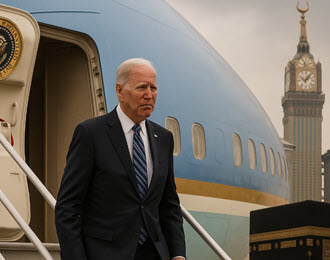Biden Visits the Middle East
26-05-2025 - Posted by Geert-JanOriginally posted on July 16, 2022 – by Andre Piet
At the end of 2020, under the leadership of then-U.S. President Trump, agreements were rapidly concluded between Israel and numerous Arab states. For some time, there had already been treaties with Jordan and Egypt, but suddenly the United Arab Emirates, Bahrain, and Sudan joined as well. The so-called Abraham Accords. There were whispers that Saudi Arabia, too, would join this group—something that would truly be spectacular. The guardian of the two holiest sites in Islam, Mecca and Medina, and moreover the largest and wealthiest Arab nation. But with the inauguration of the new American president, progress toward new agreements in the Middle East also stalled.
Biden’s Visit to the Middle East
This month marks the first time President Biden is making a two-day visit to the Jewish state. It was his predecessor Trump who, at the beginning of his term, moved the American embassy from Tel Aviv to Jerusalem, and Biden does not dare to reverse that decision. Trump remains very popular in Israel, but oddly enough also in Saudi Arabia. Biden, on the other hand, reluctantly flew today from Jerusalem to Jeddah, the second city of Saudi Arabia. He had previously referred to Saudi Arabia as a pariah state, but he cannot ignore it; he needs the country. In the coming days, a meeting is scheduled with several Gulf states, Jordan, Iraq, and Egypt. Biden certainly does not appear to be the man who will give an impulse to the existing Abraham Accords, but… neither can he undo them. For instance, in recent days, Saudi Arabia officially opened its airspace to Israeli aviation. In other words, developments are ongoing. Biden’s current visit to the Middle East confirms this.
A Sinister Cocktail
Meanwhile, other factors are also playing an important role in the background. Naturally, there is the war in Ukraine and the sanctions imposed on Russia, which may cause entire regions of the world to be deprived of gas, oil, and food. But also consider the nuclear threat from Iran, which, incidentally, will be visited next week by Russian President Putin. Indeed, international conflicts call for the formation of power blocs and alliances. Not so much out of friendship, but because of the threat of a common enemy. How these factors will unfold in the near future, no one can say. Especially when we must also take into account a severe economic recession in the Western world, which goes hand in hand with inflation and currency devaluation. All in all, it seems a sinister cocktail…
The Prophetic Setting
What we do know, in any case, is that the prophetic setting is under construction, and that the foretold period of two thousand years is nearing its end. The first thing we may expect from prophecy is the appearance of the rider on the white horse (Revelations 6). A spectacular (false) peace will emerge in the Middle East, in which ten nations will close ranks in an alliance with the Jewish state. Against that backdrop, the temple service in Jerusalem will also be restored in due time. And furthermore, the financial-economic center of the world will shift to the plain of Shinar (Babylon) in Iraq.
Not Smoothly…
Exactly how and how quickly these things will come to pass remains to be seen. Certainly, quite a few things will still need to happen. And that such a reset of the world order will not proceed smoothly seems to me an understatement. We shall see, and follow the developments attentively and with great interest—naturally, in the light of the prophetic word. The end of the current eon is in sight. Its days are numbered. And then… then a new eon will dawn. Most assuredly!

 English Blog
English Blog